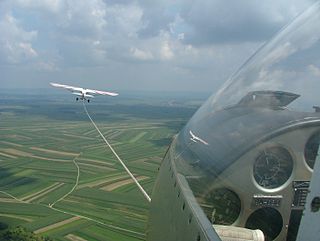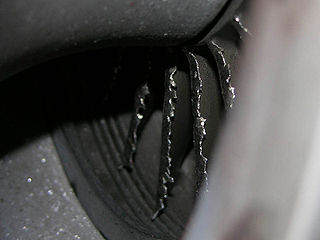
An aircraft is a vehicle that is able to fly by gaining support from the air. It counters the force of gravity by using either static lift or the dynamic lift of an airfoil, or, in a few cases, direct downward thrust from its engines. Common examples of aircraft include airplanes, helicopters, airships, gliders, paramotors, and hot air balloons.

A hot air balloon is a lighter-than-air aircraft consisting of a bag, called an envelope, which contains heated air. Suspended beneath is a gondola or wicker basket, which carries passengers and a source of heat, in most cases an open flame caused by burning liquid propane. The heated air inside the envelope makes it buoyant, since it has a lower density than the colder air outside the envelope. As with all aircraft, hot air balloons cannot fly beyond the atmosphere. The envelope does not have to be sealed at the bottom, since the air inside the envelope is at about the same pressure as the surrounding air. In modern sport balloons the envelope is generally made from nylon fabric, and the inlet of the balloon is made from a fire-resistant material such as Nomex. Modern balloons have been made in many shapes, such as rocket ships and the shapes of various commercial products, though the traditional shape is used for most non-commercial and many commercial applications.

Air Canada Flight 143, commonly known as the Gimli Glider, was a Canadian scheduled domestic passenger flight between Montreal and Edmonton that ran out of fuel on Saturday, July 23, 1983, at an altitude of 41,000 feet (12,500 m), midway through the flight. The flight crew successfully glided the Boeing 767 to an emergency landing at a former Royal Canadian Air Force base in Gimli, Manitoba, which had been converted to a racetrack, Gimli Motorsports Park. It resulted in no serious injuries to passengers or persons on the ground, and only minor damage to the aircraft. The aircraft was repaired and remained in service until its retirement in 2008. This unusual aviation incident earned the aircraft the nickname "Gimli Glider."
Aviation is the design, development, production, operation, and use of aircraft, especially heavier-than-air aircraft. Articles related to aviation include:

In aviation, assisted takeoff is any system for helping aircraft to get into the air. The reason it might be needed is due to the aircraft's weight exceeding the normal maximum takeoff weight, insufficient power, insufficient available runway length, or a combination of all three factors. Assisted takeoff is also required for gliders, which do not have an engine and are unable to take off by themselves.

Aviation safety is the study and practice of managing risks in aviation. This includes preventing aviation accidents and incidents through research, educating air travel personnel, passengers and the general public, as well as the design of aircraft and aviation infrastructure. The aviation industry is subject to significant regulation and oversight.

In aviation and aerospace, the term foreign object damage (FOD) refers to any damage to an aircraft attributed to foreign object debris, which is any particle or substance, alien to an aircraft or system which could potentially cause damage to it.

USAir Flight 405 was a regularly scheduled domestic passenger flight between LaGuardia Airport in Queens, New York City, New York, and Cleveland, Ohio. On March 22, 1992, a USAir Fokker F28, registration N485US, flying the route, crashed in poor weather in a partially inverted position in Flushing Bay, shortly after liftoff from LaGuardia. The undercarriage lifted off from the runway, but the airplane failed to gain lift, flying only several meters above the ground. The aircraft then veered off the runway and hit several obstructions before coming to rest in Flushing Bay, just beyond the end of the runway. Of the 51 people on board, 27 were killed, including the captain and a member of the cabin crew.

A hybrid airship is a powered aircraft that obtains some of its lift as a lighter-than-air (LTA) airship and some from aerodynamic lift as a heavier-than-air aerodyne.

Hot air ballooning is the recreational and competitive adventure sport of flying hot air balloons. Attractive aspects of ballooning include the exceptional quiet, the lack of a feeling of movement, and the bird's-eye view. Since the balloon moves with the direction of the winds, the passengers feel absolutely no wind, except for brief periods during the flight when the balloon climbs or descends into air currents of different direction or speed. Hot air ballooning has been recognized by Fédération Aéronautique Internationale (FAI) as the safest air sport in aviation, and fatalities in hot air balloon accidents are rare, according to statistics from the National Transportation Safety Board (NTSB).

Belavia Flight 1834 was a scheduled international passenger flight from Yerevan, Armenia, to Minsk, Belarus, operated by Belavia. On the morning of February 14, 2008, the Bombardier Canadair Regional Jet carrying 18 passengers and three crew crashed and burst into flames shortly after take off from Zvartnots International Airport near Yerevan, the capital of Armenia.
The provision of rescue and firefighting services (RFFS) at all airports and aerodromes in the United Kingdom is a requirement under British law and under international agreements set out by the International Civil Aviation Organization.

On 7 January 2012, a scenic hot air balloon flight from Carterton, New Zealand, collided with a high-voltage power line while attempting to land, causing it to catch fire, disintegrate and crash just north of the town, killing all eleven people on board.

"G. Paolucci" Airport is an Italian airport located in 'I Piani' in Pavullo, about 2 km south of Pavullo nel Frignano, Italy. The airport is used for general aviation, business aviation, leisure and sport aviation activities, and for civil protection and rescue functions. Inside there is both a flight school for piloting gliders, and a motorized flight school for VDS equipment, basic and advanced, with the possibility of making preparatory flights to the teaching activity.
Flight time or block time is an aviation term referring to the total amount of time spent piloting aircraft, and serves as the primary measure of a pilot's experience. Flight time is defined by International Civil Aviation Organization (ICAO) as "The total time from the moment an aeroplane first moves for the purpose of taking off until the moment it finally comes to rest at the end of the flight", and thus includes time spent taxiing and performing pre-flight checks on the ground, provided the engine is running. It is colloquially referred to as "blocks to blocks" or "chocks to chocks" time. In commercial aviation, this means the time from pushing back at the departure gate to arriving at the destination gate.

West Wind Aviation Flight 282 was a domestic passenger flight from Fond-du-Lac Airport to Stony Rapids Airport, Canada. The aircraft was an ATR 42-320 registered C-GWEA. On 13 December 2017, shortly after taking off from Fond-du-Lac, the ATR-42 lost altitude and hit the ground. All 25 passengers and crew initially survived the crash, but one passenger later died of his injuries in hospital. Investigation on the cause of the crash determined that it was caused by ice contamination on the aircraft.

Aeroflot Flight 1080 was a Soviet domestic passenger flight from Yekaterinburg, Russia, to Kostanay, Kazakhstan, that crashed at night shortly after takeoff on 7 October 1978. All 38 passengers and crew were killed in the crash which occurred when one of the engines failed due to icing during initial climb out. At the time, the crash was the second worst in the history of the Yakovlev Yak-40, which had entered operational service with Aeroflot just ten years prior.

Aeroflot Flight 315 (1960) was a regularly scheduled passenger flight operated by Aeroflot from Vnukovo International Airport in Moscow to Lviv Airport in Lviv, Ukraine; at the time, both were in the Soviet Union. On 26 February 1960, the An-10 operating this flight crashed short of the airport runway while on final approach. 24 passengers and eight crew members were killed, one passenger survived.

In aviation, ground deicing of aircraft is the process of removing surface frost, ice or frozen contaminants on aircraft surfaces before an aircraft takes off. This prevents even a small amount of surface frost or ice on aircraft surfaces from severely impacting flight performance. Frozen contaminants on surfaces can also break off in flight, damaging engines or control surfaces.
Marlette Township Airport is a public use airport located one mile southwest of Marlette, Michigan. The airport is publicly owned by Marlette Township.
















